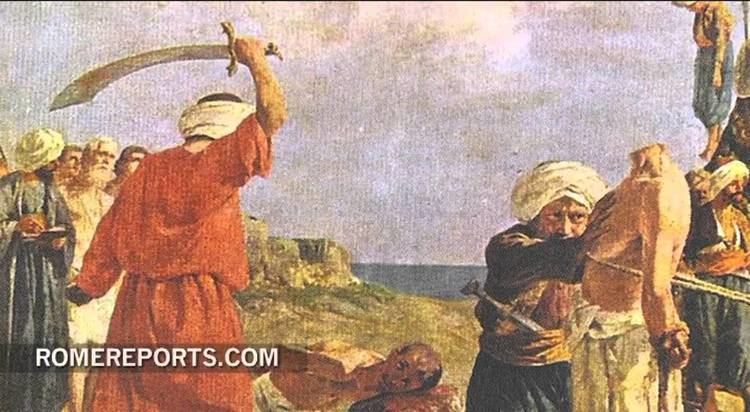Garrisoned forces surrender Unknown | Period 1480 – 1481 | |
 | ||
18,000 infantry700 cavalry128 ships UnknownHungary 2,100 Hungarian heavy infantry Result Ottoman forces seize the city; Christian forces recapture the city Similar Battle of Otlukbeli, Battle of Preveza, Siege of Belgrade, Battle of Ridaniya, Ottoman–Mamluk War | ||
Ottoman invasion of otranto
The Ottoman invasion of Otranto occurred between 1480 and 1481 at the Italian city of Otranto in Apulia, southern Italy. Forces of the Ottoman Empire invaded and laid siege to the city and its citadel. After capture, more than 800 of its inhabitants were executed. The Martyrs of Otranto are still celebrated in Italy. A year later the Ottoman garrison surrendered the city following a siege by Christian forces.
Contents
- Ottoman invasion of otranto
- Background
- Siege
- Martyrs of Otranto
- Stalled advance
- European response
- Recapture
- Aftermath
- References
Background
The attack on Otranto was part of an abortive attempt by the Ottomans to invade and conquer Italy. In the summer of 1480, a force of nearly 20,000 Ottoman Turks under the command of Gedik Ahmed Pasha invaded southern Italy. The first part of the plan was to capture the port city of Otranto.
Siege
On July 28, 1480, an Ottoman fleet of 128 ships -including 28 galleys – arrived near the Neapolitan city of Otranto. Many of these troops had come from the siege of Rhodes. The garrison and citizens of Otranto retreated to the Castle of Otranto. On 11 August, after a 15-day siege, Gedik Ahmed ordered the final assault. When the walls were breached the Turkish army methodically passed from house to house, sacking, looting and setting them on fire. Upon reaching the cathedral, "they found Archbishop Stefano Agricolo, fully vested and crucifix in hand" awaiting them with Count Francesco Largo, the garrison commander and Bishop Stefano Pendinelli, who distributed the Eucharist and sat with the women and children of Otranto while a Dominican friar led the faithful in prayer. A total of 12,000 were killed and 5,000 enslaved, including victims from the territories of the Salentine peninsula around the city, and the cathedral turned into a mosque.
Martyrs of Otranto
According to a traditional account, a small group of 800 were left alive, whom the Turks tried to forcibly convert. Eight hundred men chained together, who had lost home and family, were given the option of Islam or death, and chose death. One man, a textile worker named Antonio Primaldo Pezzula, turned to his fellow citizens and declared: "My brothers, we have fought to save our city; now it is time to battle for our souls!" The 800 men, aged 15 and older, unanimously decided to follow Antonio's example and offered their lives to Christ.
The Turks offered to return their women and children from the chains of slavery if the men would embrace Islam, and threatened the men with beheading if they refused to agree. The men still refused. On 14 August 1480, on the vigil of the Assumption, the 800 men were led outside the city and beheaded by the Turks. Their remains were later collected and are to this day kept in the Cathedral of Otranto.
The Martyrs of Otranto were collectively canonized as saints by the Roman Catholic Church in 12 May 2013. Their remains are claimed to be stored today in Otranto Cathedral and in the church of Santa Caterina a Formiello in Naples.
The traditional Christian historiography has come under criticism by later historians. Recent scholarship has questioned whether conversion was imposed as a condition for clemency. Although one contemporary Ottoman account justifies the massacre on religious grounds, Ilenia Romana Cassetta writes that it seems rather to have been a punitive action whose goal was intimidation.
Stalled advance
In August 1480, 70 ships of the fleet attacked Vieste. On September 12, the Monastero di San Nicholas di Casole, which accommodated one of the richer libraries of Europe, was destroyed. By October attacks had been conducted against the coastal cities of Lecce, Taranto and Brindisi.
However, due to lack of supplies, the Ottoman commander, Gedik Ahmed Pasha, did not consolidate his force's advance. Instead he returned with most of his troops to Albania leaving a garrison of 800 infantry and 500 cavalry behind to defend Otranto. It was assumed he would return with his army after the winter.
European response
Since it was only 27 years after the fall of Constantinople, there was some fear that Rome would suffer the same fate. Plans were made for the Pope and citizens of Rome to evacuate the city. Pope Sixtus IV repeated his 1471 call for a crusade. Several Italian city-states, Hungary and France responded positively to this. The Republic of Venice did not, as it had signed an expensive peace treaty with the Ottomans in 1479.
In April 1481 Sixtus IV called for an Italian crusade to liberate the city, and Christian forces besieged Otranto in May 1481. An army was raised by king Ferdinand I of Naples to be led by his son Alfonso, Duke of Calabria. A contingent of troops was provided by king Matthias Corvinus of Hungary.
Recapture
Between August and September 1480, King Ferdinand of Naples, with the help of his cousin Ferdinand the Catholic and the Kingdom of Sicily, tried unsuccessfully to recapture Otranto. The Christian forces besieged the city on May 1, 1481. The Turks surrendered in August and left Otranto in September 1481, ending the 13-month occupation.
Aftermath
The number of citizens, said to have been nearly 20,000, had decreased to 8,000 by the end of the century. Out of fear of another attack, many of these left the city in the following decades.
